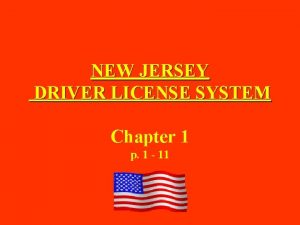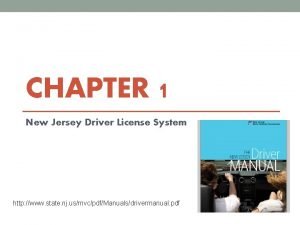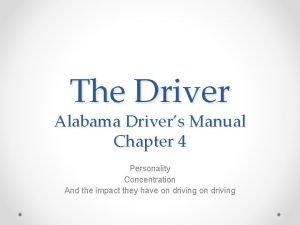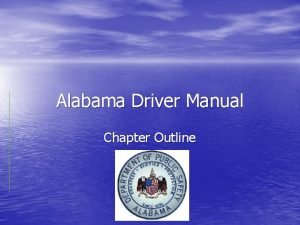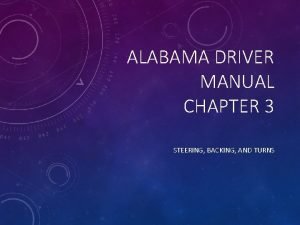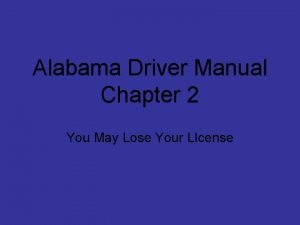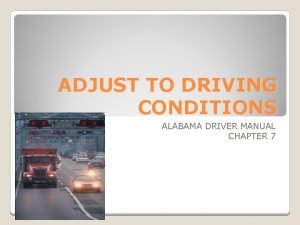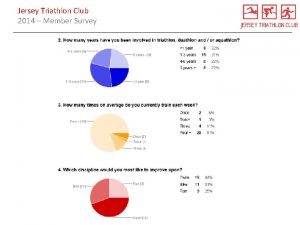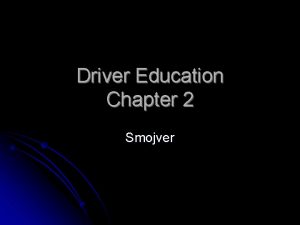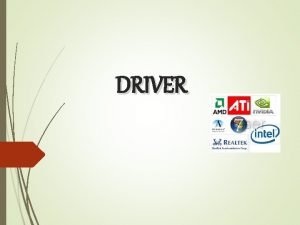THE NEW JERSEY DRIVER MANUAL Chapter 3 Driver




















- Slides: 20

THE NEW JERSEY DRIVER MANUAL Chapter 3 Driver Safety and the Rules of the Road

New Jersey’s Seat Belt Law � All front seat passengers must wear a seatbelt. � Drivers with GDL permits/provisional licenses and all of their passengers must wear seatbelts � Wearing a seatbelt increases your chance of surviving a crash by 60% Page 38

Seatbelts Help in Many Ways Keeps you from being thrown from the vehicle in a collision ü Slow the body down with the vehicle ü Keeps you from sliding during sudden stops and turns/aids in keeping driver in place to control vehicle Page 38

http: //www. youtube. com/watch? v=TWLmoeo. Hr. P 4 http: //www. youtube. com/watch? v=HFX 9 k. Qwe. HZ 4

Child Restraint Law � Children up to age 8 or weight of 80 lbs must ride in a federally approved safety or booster seat in the rear of the vehicle. � Children under age 8 and over 80 lbs must be in the rear seat and use a seatbelt. ü If a passenger in the front seat is over 18 and caught not wearing a seat belt, he/she is held responsible. Page 40

Before you Drive � Check around your car � Adjust Seat � Seatbelt! � Check windows and mirrors � Lock doors Page 44

Steering Hand Position Hand-Over-Hand Steering � Use the horn to signal when passing or when coming out of a blind alley, curve or driveway. � � Should be able to be heard from 200 ft Page 46

Stopping Distances Dependent upon: � Motorist reaction time � Weather and road conditions � Vehicle Weight � Brake Conditions � Condition and type of tires � Roadway conditions � Speed Three-second rule *The faster a vehicle is going, the longer it will take to stop. When a motorist must stop quickly, speed can be the difference between life and death. http: //www. youtube. com/watch? v=y. VBf. MMMUs. Gs Page 47

Following Distances To maintain a proper following distance when driving, you should stay at least 3 seconds behind the vehicle in front of you.

Driver Signals At least 100 feet before turning � Cancel the signal after the turn Stop or slowing down: hand arm downward, palm facing to the rear Right turn: hand arm upward Left turn: hand arm straight out Page 49

Driving in Reverse In order to steer the car while moving backward, you should turn the steering wheel in the direction you want the rear of the car to go � ROAD TEST- back the vehicle about 100 feet in a straight line, slowly and smoothly To back your car in a straight line you should turn your head and body to the right (looking over your right shoulder) until you can see clearly through the back window, and back up slowly Page 49

* What not to do backing up http: //www. youtube. com/watch? v=QS 21 Twx. PXm 8

Turning 1. Mirrors- behind and both sides 2. Check for less visible vehicles 3. Get into proper lane and signal at least 100 feet before turning* 4. Slow down before reaching an intersection 5. Steady speed and follow pavement markings 6. Same lane until turn is finished 7. Cancel turn after turn is finished 8. Never back up if a turn is missed Page 50

U-Turn � U-turn http: //www. youtube. com/watch? v=zs 7 Y Wsdw. Va 8 Why it must be legal! http: //www. youtube. com/watch? v=tri. NK gduw 6 s

3 -Point Turn (K Turn) 1. Start from the right edge of the road. Choose a safe spot with good visibility in both directions 2. Signal left and move forward slowly. Stop several inches from the left curb/street edge. 3. Signal right and back slowly. Stop several inches from the right curb or street edge. 4. Move the vehicle forward, signaling left, while turning the steering wheel to the left. 5. Finally, straighten the vehicle’s wheels as it faces in the direction he/she wants to go. 6. Required to make this turn during MVC’s road test!! http: //www. youtube. com/wa tch? v=b. SQ 5 xy. XUo. PU http: //www. youtube. com/wa tch? v=i. LKR 9 t. Ciwv. A Page 51

Parking Facing Downhill: � Set hand brake � Turn wheels toward curb � Vehicle should be in park (manual- reverse) Page 51 Facing Uphill: � Set hand brake � Turn wheels away from curb � Vehicle should be in park (manual- reverse)

Hill http: //www. youtube. com/watch? v=i. Gyih. DZKXt. A � http: //www. youtube. com/watch? v=V-7 r. PTs 8 e 8 U

Parallel Parking Must be able to parallel park in order to pass Road Test! Markers are 25 ft apart 1. Find a large enough parking space 2. Signal for a stop and signal to the right to alert motorists that the vehicle will back up to the right. 3. Pull up alongside (parallel) about two to four feet from the vehicle in front. 4. Turn and check to see that the way is clear behind the vehicle before backing up. 5. Turn body to look out the rear window. Back up slowly for about 2 ft and turn the steering wheel all the way to the right. Page 53

Parallel Parking 5. When the front of the vehicle has cleared the rear bumper of the vehicle in front, stop and check the angle. 6. Make sure the right back wheel has not hit the curb. 7. Turn the steering wheel all the way to the left while beginning to back up slowly. Make sure the vehicle can clear its back bumper. 8. When the vehicle is in line, stop. Be sure not to hit the vehicle in back. 9. Turn the vehicle’s wheels straight, and drive to the center of the parking space. The vehicle’s tires should be no more than six inches from the curb. Page 53

Parallel parking http: //youtu. be/je. FNunn. Yi. KY http: //www. youtube. com/watch? v=Q 23 Hp. Nk. M 8 gs http: //www. youtube. com/watch? v=Z 7 b. JUc 4 q. TNw http: //www. youtube. com/watch? v=k. S 99 XYyf 2 Hc&feat ure=Play. List&p=2 D 32 C 73168096818&playnext=1 &playnext_from=PL&index=39 �
 New jersey driver manual
New jersey driver manual Getting a drivers license illegally may result in
Getting a drivers license illegally may result in Chapter 1 nj driver license system
Chapter 1 nj driver license system Chapter 1 the new jersey driver license system answers
Chapter 1 the new jersey driver license system answers New york pennsylvania new jersey delaware
New york pennsylvania new jersey delaware Texting and driving laws in alabama
Texting and driving laws in alabama Driver manual chapter 1 assessment
Driver manual chapter 1 assessment Push and pull steering
Push and pull steering Driver manual chapter 2 assessment
Driver manual chapter 2 assessment Driver manual chapter 7 assessment
Driver manual chapter 7 assessment Universal waste examples
Universal waste examples New jersey space grant consortium
New jersey space grant consortium 4 regions of nj
4 regions of nj New jersey center for teaching and learning
New jersey center for teaching and learning New jersey center for teaching and learning
New jersey center for teaching and learning Nj board of bar examiners
Nj board of bar examiners Jersey accent video
Jersey accent video Triathlon club new jersey
Triathlon club new jersey Nj dyslexia handbook
Nj dyslexia handbook New jersey plan
New jersey plan New jersey grants & scholarships 2020-21
New jersey grants & scholarships 2020-21


